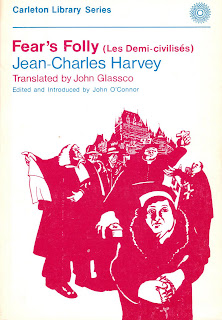
So big, so close, so powerful, and yet New York doesn't really feature much in Canadian literature. The city rarely serves as a setting, and not all that many of our notable writers have called it home – Arthur Stringer and Thomas B. Costain just aren't names we pay much attention to these days. Still, Ralph Gustafson spent much of the Second World War in Manhattan working for British Information Services. Brian Moore lived in the city for a few years – two of his finest novels, An Answer from Limbo and I Am Mary Dunne, feature New York as a setting. In Travels by Night, George Fetherling writes that the city served as something of a way-station between West Virginia and Ontario.
I'd argue that our greatest canonical connection properly belongs to Major John Richardson, he of Wacousta fame, who took up residence in New York in the autumn of 1849. On the surface it seems such a smart move; he produced several bestsellers. However, this did not translate into coin. After two years in the city, on 12 May 1852, Richardson died in his lodgings at 113 West 29th Street. Cause of death: erysipelas. John Dryden died of the disease, as did John Stuart Mill. Charles Lamb fell, cut on his face and succumbed to the malady. Richardson's erysipelas was brought on by malnutrition – in short, 'the first Canadian novelist' wasn't earning enough to feed himself. Richardson's funeral took place two days later at the Church of the Holy Communion, corner of 6th Avenue and West 20th Street. His body was then transported outside the city, presumably to be buried.
As a young man, I knew the Church of the Holy Communion as the Limelight, a dance club I would pass on what were then frequent visits to New York. The hedonistic playground of Michael Alig's coked-out Club Kids, a building Reverend Muhlenberg intended as 'an oasis of Christian activity in the city', it ended up at the centre of the Angel Melendez murder.*
 The structure once known as the Church of the Holy Communion now serves as a clearing house for clothing samples. The days of debauchery and indulgence are past, but the sacrilege continues.
The structure once known as the Church of the Holy Communion now serves as a clearing house for clothing samples. The days of debauchery and indulgence are past, but the sacrilege continues.
Richardson's lodgings are long gone, but the Church of the Holy Communion still stands. A beautiful Gothic Revival building, the vision of Anglo-American architect Richard Upjohn, it once counted John Jacob Astor and Cornelius Vanderbilt amongst its parishioners. Richardson was a steadfast follower of its rector, evangelical Episcopalian Reverend William Augustus Muhlenberg.
As a young man, I knew the Church of the Holy Communion as the Limelight, a dance club I would pass on what were then frequent visits to New York. The hedonistic playground of Michael Alig's coked-out Club Kids, a building Reverend Muhlenberg intended as 'an oasis of Christian activity in the city', it ended up at the centre of the Angel Melendez murder.*
 The structure once known as the Church of the Holy Communion now serves as a clearing house for clothing samples. The days of debauchery and indulgence are past, but the sacrilege continues.
The structure once known as the Church of the Holy Communion now serves as a clearing house for clothing samples. The days of debauchery and indulgence are past, but the sacrilege continues.
* Those possessing a morbid curiosity and strong stomach may have an appetite for James St James' Disco Bloodbath (New York: Simon & Schuster, 1999), an account of his time in the Limelight, and the Melendez murder and dismemberment. St James, a transplanted Indianan and former Club Kid writes, 'if its superficial that my response to murder is to stop wearing false eyelashes – then goddamnit – SO BE IT.' Goddamnit, indeed.




















